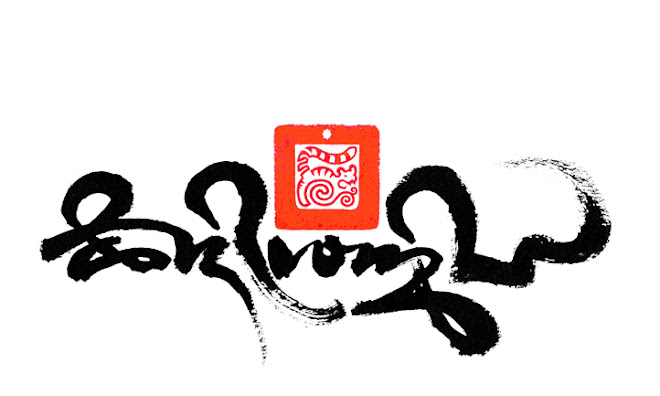 |
| A sample of a woodblock print showing both Uchen and Lantsa Sanskrit, the original script style of the Buddhist manuscripts of India in the 6th century. |
Perhaps the most well known Tibetan script style in the West is the classical Uchen script དབུ་ཅན། recognisable by it's distinct angular appearance, especially in the straight heads of the letters that align horizontally; from which the rest of the letter hangs down from.
The name Uchen translates as 'with head', as apposed to another class of Tibetan script styles 'without head' called Umé དབུ་མེད།
དབུ་ཅན།
Historically the Uchen script style was developed to accommodate the translation from Sanskrit and the reproduction of the Buddhist teachings that migrated from India into Tibet around the 7th century A.D.
As Buddhist literature was commonly reproduced in Tibet as wood block prints, the Uchen script was further adapted to lend its self as a more practical script style for hand carving the wood blocks. Because of this employment of the Uchen script; it is sometimes known as 'block script', which also describes its angular appearance, very much as a result of the nature of wood carving.
 |
| Woodblock printing Tibetan manuscripts, this ancient form of printing is still being practiced at the famous printing house in Dege, East Tibet. |
Although Uchen is known as the classical script style and has an important role in Tibetan Buddhism, there are far less Tibetans that actually write Uchen. Tibetan handwriting is more practically practiced with the faster cursive Umé class of styles, as apposed to Uchen which takes much more care and time to construct.
 |
"The Four Noble Truths"Japanese mineral paint on Bhutanese Tsasho bark fiber paper, 58x80 cm |
Above is a clear example of a hand painted Uchen script, this particular style is a 'high' form of Uchen, used mostly for the head page of illuminated manuscripts, this style derives from a text of the 15th-16th century from the great Tsurphu monastery in central Tibet, famously known as the seat monastery of the Karmapa's.
དབུ་མེད།
There are many different forms of the Umé scripts, when learning Umé there is a specific chronological order, from the more uniformed constructive forms called Tsugring ཚུགས་རིང། meaning long form and Tsugtung ཚུགས་ཐུང་། meaning short form, to the more cursive styles གཤར་མ། of which there is the every-day writing styles of Khyug dri འཁྱུག་བྲིས། meaning nimble writing and Kyug dri རྒྱུགས་བྲིས། meaning quick writing.
There are other intermediate script styles བར་བྲིས། such as Tsugmakhyug ཚུག་མ་འཁྱུག། a sub style between Tsugtung and Khyug yig. Petsug དཔེ་ཚུགས། often used for hand-written texts and books, of which is traditionally associated with different regions of Tibet, such as the Khamyig ཁམས་ཡིག། a script style referring to the Eastern Provence called Kham.
For the more artistic form of calligraphy Drutsa འབྲུ་ཚ། is used, this script style is particularly flamboyant and cursive in style, traditionally used for official documents and titles.
In old Tibet the monasteries where the great power houses of learning, they provided education starting at a young age, a number of schools and universities could be found within the grounds of the larger monasteries, where learning to read and write the Buddhist scriptures was an important part of the monastic education.
ཚུགས་རིང།
The first script style to be mastered is Tsugring or sometimes spelt sugring སུག་རིང། meaning long limb, indicating the distinct character of this script style as long height of the letters.
Much practice with a steady hand is needed to pull the long tails or limbs of the letters to a straight unwavering vertical line. As paper was an expensive commodity in Tibet, young monks practice on slates or black painted wooden pallets called "Jangshing", these are marked with construction lines at the desired proportion, then dusted with chalk.
A bamboo cut pen is then dipped into water, the letters are then marked through the chalk dust, to be practiced over and over re-chalking the pallet each time.
 |
| A young Tibetan monk practicing the Tsugring handwriting style, Photograph courtesy of Shannon O'Donnell. |
Once the Tsugring script style is mastered, then the student moves onto the next script style of Tsugtung, (a shorter form of Tsugring) accomplishing each style respectfully; until the more quick/swift Khyug script styles are achieved, only then may a student be inclined to learn to write the Uchen style.
 |
| Corresponding script styles of the first five letters with the four vowel signs of the Tibetan alphabet |
Here below is the first part of the Alphabet in the Tsugring script is shown with the construction lines as a guide for neat handwriting and to give the correct letter proportion.
དཔེ་ཚུགས།
The next script style is Petsug ,often used for the publication of books, as this script style has a distinctive short angular style with short vowel signs, this means that the lines of text can be placed closer together. It was commonly used in the Kham Province of East Tibet, which lends it another name Khamyig, meaning ‘writing of Kham’.















